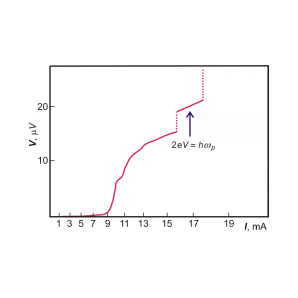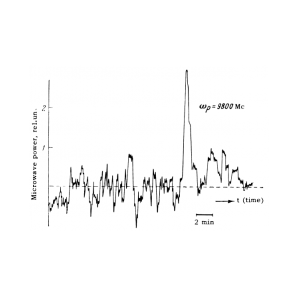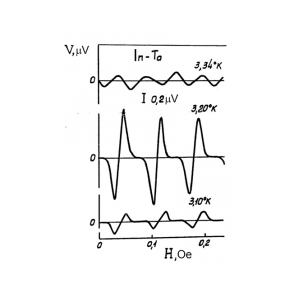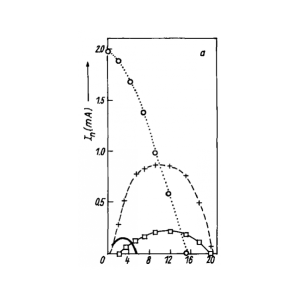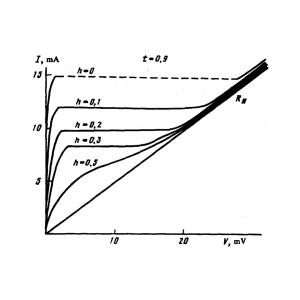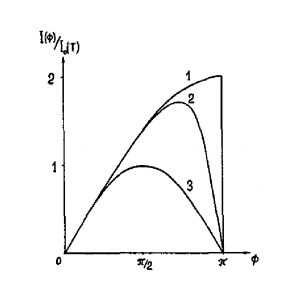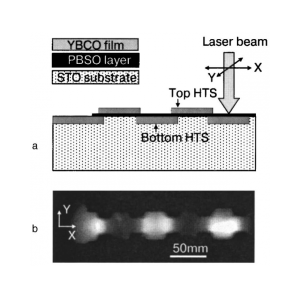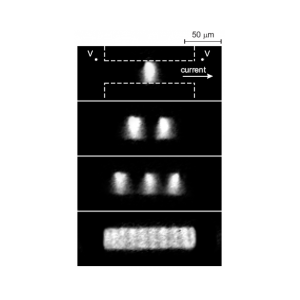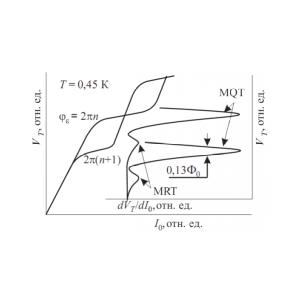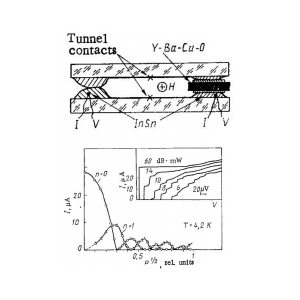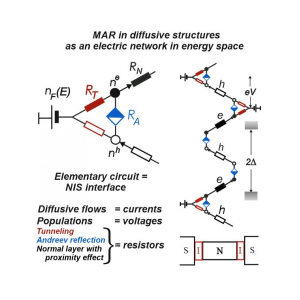History of our Department
The Department is of the same age as the Institute itself being created in 1960 as a division of “Low-temperature electronics”. It was really a bright foreseeing. After B. Josephson had discovered his famous effects in 1962 that opened a new era of superconducting electronics, young researchers in the Department were the first in the world who managed to directly measure microwave emission from superconducting tunnel junction in 1965. Also, the first dc-SQUID magnetometer in USSR was also created here in 1967. A number of worldwide significant results were obtained by talented and good-skilled scientists of the Department through the passed years. You can find some of them below in Top key results and Other principal achievements. The Department gave birth to 10 specialized departments during first 20 years of its existence. Prof. Igor M. Dmitrenko, full member of National Academy of Sciences of Ukraine Ukraine
Below you may want to find results obtained by the Department fellows.
Top key results
Deviation of current-phase relation from pure sine is experimentally revealed in Josephson point contacts while studying oscillations of Shapiro steps with the microwave power. An algorithm for reconstruction of real current-phase relation in the form of Fourier series is proposed for the junctions with strong Josephson coupling (I. M. Dmitrenko, Yu. G. Bevza, V. I. Karamushko, 1973). 

Theory of Josephson effect in mesoscopic weak links was built (I. O. Kulik, A. N. Omelyanchouk, 1978).
Fiz. Nizk. Temp. 3, 945 (1977) [Sov. J. Low Temp. Phys. 3, 840 (1977)], Fiz. Nizk. Temp. 4, 296 (1978) [Sov. J. Low Temp. Phys. 4, 142 (1978)]
New non-equilibrium resistive state in wide superconducting thin films was discovered. The conception of Phase Slip Lines which are the 2-D analogues of phase slip centers was introduced (I. O. Dmitrenko, V. G. Volotskaya, A. G. Sivakov 1981). 
 - Awarded by State Prize in 2000 as a part of wider studies. Phase transition with generation of PSLs in uniform wide superconducting strip was visualized with low-temperature scanning laser microscope (A. G. Sivakov, A. M. Glukhov, A. N. Omelyanchouk, 2003).
- Awarded by State Prize in 2000 as a part of wider studies. Phase transition with generation of PSLs in uniform wide superconducting strip was visualized with low-temperature scanning laser microscope (A. G. Sivakov, A. M. Glukhov, A. N. Omelyanchouk, 2003). 
Macroscopic Quantum Tunneling (MQT) and Macroscopic Resonance Tunneling (MRT) of superconducting loop of rf SQUID with small size ScS Josephson junction have been experimentally demonstrated (V. I. Shnyrkov, V. A. Khlus, G. M. Tsoi, I. M. Dmitrenko, 1985).
Fiz. Nizk. Temp. 11, 146 (1985) [Sov. J. Low Temp. Phys. 11(2), 77 (1985)]
The phenomenon of the macroscopic quantum superposition of states of an rf SQUID with atomic size ScS junction was revealed in experiment (V. I. Shnyrkov, G. M. Tsoi, D. A. Konotop, I. M. Dmitrenko, 1985-1991).
[I. M. Dmitrenko, G. M. Tsoi, V. I. Shnyrkov. Quantum decay of metastable current states of a superconducting interferometer. Proceedings of 2nd All-USSR meeting “Quantum metrology and fundamental physical constants”, NPO VNIIM, Leningrad Berlin Germany
Electron pairing in high-temperature superconductor (YBCO) is experimentally proved for the first time (B. I. Verkin, S. I. Bondarenko, V. M. Dmitriev, V. P. Seminozhenko, A. V. Lukashenko, A. A. Shablo, 1987).
[Sov. J. Low Temp. Phys. 13, 568 (1987)]
DC current transport in the incoherent regime of multiple Andreev reflections (MAR) is studied in long diffusive SNS junctions with arbitrary transparencies of NS boundaries. A circuit representation of MAR in diffusive structures is formulated as an equivalent electrical network in energy space - an analogue of the Klapwijk-Blonder-Tinkham approach for ballistic structures. New resistive element "Andreev resistor" is introduced (E. V. Bezuglyi in collaboration with the Institute colleagues, 1997). 
Other principal achievements
1960-1969
• First in the USSR
• First studies of Josephson properties of S-N-S weak links and quantum interferometers based on them are made (S. I. Bondarenko, I. M. Dmitrenko, 1969).
1970-1979
• Superconducting planar resonators with one and two Josephson point contacts are explored for the first time (S. I. Bondarenko, I. M. Dmitrenko, T. P. Narbut, 1970).
• Theoretical investigation of thermomagnetic and magnetoacoustic size effects in the intermediate state of type-I superconductors emerging due to Andreev reflections of quasiparticles from the interphase boundaries (E. V. Bezuglyi, 1971-1979).
• Normal metal-superconductor interface movement under small temperature gradient is experimentally investigated for the first time, full Meissner effect and record-breaking magnetic vacuum in a superconducting magnetic hollow-cylinder shield are achieved (S. I. Bondarenko, V. I. Sheremet, 1973).
• Superconducting niobium-germanium thin films with the highest (until 1986) critical temperature are made and tested for the first time in USSR
• Study of classical dynamics in quantum interference device (rf SQUID): hysteretic and non-hysteretic regimes, adiabatic, equilibrium and non-adiabatic limits, the influence of energy relaxation time, stochastic oscillations and chaos, thermal fluctuations, improving rf SQUID energy resolution up to quantum limit, application of rf low-Tc and high-Tc to physical experiments (V. I. Shnyrkov, G. M. Tsoi, V. A. Khlus, D. A. Konotop, I. M. Dmitrenko, 1975-1982).
• XYZ SQUID magnetometer for land geophysical works is developed and tested in field conditions for the first time in USSR
1980-1989
• The first prototype of Low-Temperature Laser Scanning Microscope (V. A. Konovodchenko, A. P. Zhuravel, V. G. Efremenko, B. B. Banduryan, 1980).
• The mechanism of limitation in stimulation of superconductivity by microwave field with Eliashberg effect was revealed by numerical calculation and experimentally studied (Yu. G. Bevza, V. I. Karamushko, I. M. Dmitrenko, O. G. Turutanov, 1980).
• Abnormal (non-thermal) hysteresis in I-V curves of vanadium granulated thin films as a “Josephson media” in magnetic field was experimentally discovered (Yu. G. Bevza, O. G. Turutanov, 1980).
• Prediction and investigation of the electron collective modes in normal metals and superconductors: Carlson-Goldman mode, zero sound and diffusion modes, magnetoplasma and beam waves, quasiwaves and solitons (E. V. Bezuglyi, in collaboration with ILTPE experimentalists, 1981–2011).
• Thin film multi-loop SQUID magnetometers and SQUID gradiometers of high sensitivity and noise immunity are developed for the first time in USSR
• Airborne SQUID gradiometer for geomagnetic studies is developed and successfully tested for the first time in the world (S. I. Bondarenko, V. V. Kravchenko, E. A. Golovanev, E. N. Tilchenko, V. A. Samarsky, G. V. Bezuglaja, 1984).
• The reduction of shot noise in ballistic point contacts is predicted (I. O. Kulik, A. N. Omelyanchouk, 1984).
• The effect of electrical polarization of superconductors caused by Bernoulli potential is predicted (Yu. M. Ivanchenko, A. N. Omelyanchouk, 1985).
• Theoretical predictions of effect of Coulomb gap at hopping conductivity with varying hop length and percolation nature of superconducting transition in granulated superconductors are experimentally approved (A. M. Glukhov, N. Ya. Fogel, A. A. Shablo, 1985-1986).
• The control methods of coordinate sensitivity of superconducting bolometric structure by the external local exposure were developed and substantiated in theory (V. A. Konovodchenko, B. B. Banduryan, V. E. Butovsky, V. G. Efremenko, A. P. Zhuravel, V. Yu. Lavreshin, G. V. Shustakova, 1986–1991. Author's certificate 1376851, 1986).
• The mechanisms of the response on electromagnetic radiation, as well as bolometric and noise properties of thin film HTSC structures, were experimentally studied. The criteria for assessing of the HTSC film quality were developed. The photodetectors based on HTSC microbolometers were created and implemented (B. B. Banduryan, I. M. Dmitrenko, V. G. Efremenko, V. Yu. Lavreshin, G. V. Shustakova, other institution colleagues, 1988–1991).
• Thin film dc HTS quantum interferometer is developed and tested for the first time in USSR
1990-1999
• Experimental observation of the interaction of the phase-slip lines in wide superconducting films (A. G. Sivakov, A. P. Zhuravel, I. M. Dmitrenko, V. G. Volotskaya, O. A. Koretskaya, 1992).
• High-Tc RF SQUID with natural intergrain Josephson junctions were studied. Liquid-nitrogen cooled SQUID was created with record-breaking sensitivity of 2х10-13 T in 1 Hz frequency band (D. A. Konotop, S. S. Khvostov, V. P. Timofeev, 1993).
• New universal mechanism of 1/f noise is suggested in fractal percolative thin films which is the passive transformation of any natural fluctuation with a fractal-type transfer function (A. M. Glukhov, I. M. Dmitrenko, A. E. Kolinko, 1997).
• Theory of current transport in voltage biased superconducting structures: atomic-size ballistic contacts, point-like and planar diffusive junctions, Andreev interferometers. Creation of the circuit theory of multiple Andreev reflections in SNS junctions - generalization of the Klapwijk-Blonder-Tinkham theory for the diffusive case (E. V. Bezuglyi, in collaboration with ILTPE and foreign scientists, 1997-2014).
2000-2009
• Study of the transport in low-dimensional normal systems under the impact of nuclear spin polarization and spin-orbit interaction. The concept of nuclear-spin-polarization-induced structures was proposed (S. N. Shevchenko 1999-2004). Phys. Rev. B 66, 035303 (2002).
• Theoretical study of full-counting statistics of the charge transfer in mesoscopic normal and superconducting structures, prediction of giant shot noise in voltage biased superconducting junctions (E. V. Bezuglyi, in collaboration with ILTPE and foreign scientists, 1999-2004).
• A study of intrinsic pinning and commensurability of vortex lattice with layering period in Mo/Si and W/Si superconducting multilayers (M. Yu. Mikhailov, O. I. Yuzephovich, 1999-2005).
• Portable magnetometers were designed on the base of the earlier developed HTSC RF SQUIDs, one of which was implemented in Korea Atomic Energy Research Institute (KAERI) for novel methods for non-destructive testing of construction materials (V. P. Timofeev with collaboration with foreign colleagues, 2000).
• Investigation of curved low-dimensional conductors. It was demonstrated that the distortion effective potential significantly influences the transport on nanoscale (S. N. Shevchenko, Yu. A. Kolesnichenko, 2001) JETP 92, 811 (2001).
• Study of quantum dynamics of SQUID-type flux and charge-flux qubits:
Low charge noise interferometer-type charge qubits as a single-Cooper-pair transistor closed by a superconducting loop with Josephson energy comparable with and exceeding charge energy were experimentally implemented. Temperature dependencies of Landau-Zenner and Rabi oscillations were demonstrated (V. I. Shnyrkov and foreign colleagues, 2001-2006).
Low charge noise interferometer-type charge qubits as a single-Cooper-pair transistor closed by a superconducting loop with Josephson energy comparable with and exceeding charge energy were experimentally implemented. Temperature dependencies of Landau-Zenner and Rabi oscillations were demonstrated (V. I. Shnyrkov and foreign colleagues, 2001-2006).
• XYZ HTS SQUID microscope is developed for the first time in Ukraine
• Selective stochastic-resonance input circuits for an rf SQUID with transport-current tunable 4-terminal contact are proposed (O. G. Turutanov, A. N. Omelyanchouk, V. I. Shnyrkov, 2002).
• Experimental observation of stochastic resonance in a percolative Josephsom media which occurs close to the percolation threshold (A. M. Glukhov, A. G. Sivakov and foreign colleagues, 2002).
• First observation of lock-in effect on Mo/Si and W/Si superlattices and vanadium thin films in tilted magnetic fields (M. Yu. Mikhailov, O. I. Yuzephovich, 2002).
• Theoretical study of the spin-orbit effects and thermal transport in proximity NS structures (E. V. Bezuglyi, in collaboration with ILTPE and foreign scientists, 2002-2010).
• Theory of current-carrying state in Josephson junctions between conventional and unconventional (d-wave, f-wave) superconductors with the accent on situation with the tangential transport current along the boundary (S. N. Shevchenko, Yu. A. Kolesnichenko, A. N. Omelyanchouk, 2002-2006) Low Temp. Phys. 30, 213 (2004).
• The first experimental identification of microscopic sources of microwave nonlinearities in superconductors (A. P. Zhuravel, 2003).
• The method to control the coordinate sensitivity of an HTSC bolometer structure was experimentally realized. The constructed HTSC bolometric multielement IR imager with non-contact readout of thermal field is an alternative approach for the imaging with the focal plane array (V. G. Yefremenko, E. Yu. Gordiyenko, G. V. Shustakova, other institution colleagues, 2003-2006).
• Development and the first demonstration of a spatial partition method for the high-frequency photo-response of superconducting devices correlated with inductive and resistive changes in microwave impedance (A. P. Zhuravel, 2005).
• Freezing of local magnetic field (FLMF) in HTS ceramics is studied in detail for the first time. Considerably slower relaxation of the magnetic flux in comparison with uniform FMF is found. Applicability of the FLMF to detect the uniformity of HTS samples is estimated (S. I. Bondarenko, A. A. Shablo, V. P. Koverya, N. M. Levchenko, 2006).
• Exact and complete analytical solution of the problem of the Josephson tunnel junction of arbitrary (but finite) length in the presence of external parallel magnetic fields and transport currents is obtained. Josephson vortices were shown to exist in arbitrary small (but finite) tunnel junctions provide that external magnetic fields are sufficiently high, contrary to a wide-spread and deep-rooted misunderstanding (S. V. Kuplevakhsky, A. M. Glukhov, 2006-2008).
• Superconducting nanostructures (Tc = 2.5–6.5 K) with different topology and dimensionality on the base of the heterostructures AIVBVI-type (PbTe/PbS, PbTe/YbS, PbTe/PbSe) were created. Direct evidence for interfacial superconductivity in two-layer semiconducting heterostructures was obtained (O. I. Yuzephovich, M. Yu. Mikhailov, S. V. Bengus, 2006-2008).
• The rise of effective pinning potential by an order of magnitude and more at natural defects of crystal lattice in wide class of HTSCs of various structure in low stationary magnetic field was experimentally established (V. P. Timofeev, A. A. Shablo, V. Yu. Monarkha, 2009).
• The thermal imaging system based on a single, cooled to liquid-nitrogen temperature, semiconductor detector was developed for the first time in Ukraine, with temperature sensitivity 0.1С, 256x256 elements, spatial resolution 1.5mrad, frame rate 1Hz. More than 20 specimens of this model, which have been produced in ILTPE, still successfully used in non-destructive testing of equipment, energy saving, medicine, science and other fields (V. G. Yefremenko, E. Yu. Gordiyenko, G. V. Shustakova, Yu. V. Fomenko, 1998-2009).
2010 - 2019
• The thermal imaging system based on uncooled microbolometer array was developed and prototyped with 384x288 sensitive matrix, temperature sensitivity 0.06C, spatial resolution 1.0mrad and frame rate 25Hz. To date, several samples of this model are successfully produced and implemented (E. Yu. Gordiyenko, N. I. Glushchuk, Yu. V. Fomenko, G. V. Shustakova, 2007-2012).
• Investigation of the superconducting properties of sol-gel NbN-SiO2 and VN-SiO2 granular films with controlled size of granules (O. I. Yuzephovich, S. V. Bengus in collaboration with foreign colleagues, 2010-2012).
• Finding the effect of switching nonlinearity in a superconductor-enhanced metamaterial (A. P. Zhuravel, 2012);
• Basic concept of a quantum inductance coupler (QUINC), which is a superconducting loop closed by an atomic-size ScS junction, to provide tunable interaction between two flux qubits is proposed. QUINC was shown to provide large inter-qubit interaction energies, up to 1K (V. I. Shnyrkov in collaboration with other institution colleague, 2012).
• Imaging the Anisotropic Nonlinear Meissner Effect in Nodal YBa2Cu3O7-δ Thin-Film Superconductors (A. P. Zhuravel, 2013).
• Developing of Ultra-Compact Superconductive Resonator With Double-Spiral Structure (A. P. Zhuravel, 2013).
• Imaging Coherent Response of Superconducting Metasurface (A. P. Zhuravel, 2013).
• The first experimental observation of dynamic tuning in metamaterials exhibiting electromagnetically induced transparency (A. P. Zhuravel, 2013).
• The observation of the magnetic field-tuned and transport current tuned superconductor-insulator transitions in periodical nano-structures arising on the interface of semiconducting PbTe/PbS heterostructures (O. I. Yuzephovich, S. V. Bengus, 2013-2016).
• Experimental observation of stochastic resonance in multi-well potential of an RF SQUID loop (O. G. Turutanov, V. Yu. Lyakhno, V. I. Shnyrkov, 2014).
• We studied the concept of multiple Andreev reflections, which is a universal framework explaining the nature of dissipative current in different types of Josephson junctions. Within this approach, we studied theoretically the current-voltage characteristics of a planar multichannel SNINS junction which models the Josephson field-effect transistor with the 2D electron gas as a normal connector between superconducting electrodes, affected by the controlling gate playing the role of a tunnel barrier. We suggest that the resonant features of the dc current are associated with the Andreev levels positions which thus can be measured in the experiment (E. V. Bezuglyi).
• A direct visualization of the spatial distribution of localized microwave excitations in an array of strongly connected 27x27 HF SQUIDs, which formed a magnetic metasurface for the penetration of an electromagnetic wave, was performed. The effect of the formation of individual clusters in an environment with a spatially stable dissipative state was revealed, which may be related to the non-uniform penetration of the magnetic flux in the direction of the orthogonal action of the uniform external magnetic field (A. P. Zhuravel, 2016).
• We studied the dynamics of phase-slip centers and lines in superconducting wires and strips, by numerical simulation based on full time-dependent Ginsburg-Landau equations for superconductors with the energy gap in their spectrum. Our research focused on the process of emerging of multiple phase-slip centers, as well as on the clarification of the nature of the excess current and its relation to the averaged supercurrent through the phase-slip center's core (E. V. Bezuglyi).
• The functioning the new superconducting quantum structure “interferometer-shunt inductance” requires the use of an asymmetric interferometer in it. As a result of theoretical and experimental studies of the new structure, a mathematical theory of processes in it was developed for the first time. Verification of the calculated ratios with the help of experiments confirmed their validity (S. I. Bondarenko, V. N. Fenchenko, V. P. Koverya, A. V. Krevsun, 2019).
2020 - ...
• A generalized representation of the spin singlet is obtained, the main feature of which is that the spins are mutually reversed in time. This representation determines the temporal evolution of the singlet. The existence of nontrivial quantum mechanical effects was found theoretically: a periodic transformation of a spin singlet into a zero component of a spin triplet in an external field, as well as a periodic permutation of spins inside the singlet (S. V. Kuplevakhsky, S. V. Bengus, 2018-2021).
• Metal nanoparticles and coatings based on them possess new properties previously unknown in metal physics. Their study is an urgent and important task from the point of view of application. Study of the electrical conductivity of bimetallic gold-silver coatings synthesized by a chemical method together with the Institute of Single Crystals of the National Academy of Sciences of Ukraine were carried out in the temperature range of 300-4.2K for the first time. A linear dependence of the electrical resistance of the coatings was found in the entire temperature range, and the influence of the concentration of silver on this dependence was also established. Coatings can be used to create resistance thermometers for high-precision and calibration-free measurement of low and ultra-low temperatures (A. G. Sivakov, S. I. Bondarenko, A. S. Pokhila, A. V. Krevsun, V. P. Koverya, A. S. Garbuz, 2020).
• The Fe-Te-Se compound is one of the new high-temperature superconductors, the study of the properties of which is relevant, both from the point of view of fundamental physics and in applied terms. Together with the Institute of Physics of the Polish Academy of Sciences, the effect of thermal diffusion of hydrogen on the structural properties of Fe-Te-Se single crystals was studied for the first time. After treatment of the compound samples with hydrogen at a temperature of about 200C at a hydrogen pressure of 5 atmospheres for 10 hours, a significant change in the X-ray spectra of the compound samples was detected. These changes indicated the appearance of high mechanical stresses in single crystals, the appearance of a new crystalline phase, and a decrease in the volume of the main crystal lattice by 15%. A conclusion is made about the possible strong influence of thermal diffusion of hydrogen on the superconducting properties of the compound. This assumption was later confirmed by our experimental studies (S. I. Bondarenko, V. P. Koverya, A. Wiśniewski, 2020).
• To determine the concentration of magnetic nanoparticles (MNPs) in the focus of the disease after their delivery, the acoustomagnetic method (AMM) of measuring the concentration of MNPs using a superconducting quantum magnetometer was proposed and investigated. Thanks to AMM, the ensemble of particles is driven into oscillating motion using ultrasound and oriented by an external permanent magnetic field in space. The oscillating particles generate an alternating magnetic field at an ultrasound frequency. This alternating field, proportional to the particle concentration, is recorded by a highly sensitive magnetometer. It is possible to measure the concentration of MNPs with record sensitivity and in a wide range of concentrations (S. I. Bondarenko, O. V. Krevsun, V. P. Koverya, 2020).
• Infrared camera to monitor low-temperature thermal field dynamics has been developed and prototyped (Gordiyenko, 2021).


